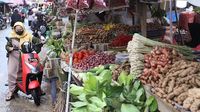On Monday, May 5, 2025, Statistics Indonesia (BPS) announced a remarkable milestone in the country’s agricultural sector, reporting that agriculture has achieved double-digit growth for the first time in 15 years. This news comes during a press conference held in Jakarta by BPS Head Amalia Adininggar Widyasanti, where she detailed the impressive figures that underline this growth.
Widyasanti highlighted that from 2010 to 2025, the agriculture sector experienced a significant boost in the first quarter, marking the highest growth rate in recent years. She stated, “This is the first time agriculture has grown in double digits in the first quarter. Therefore, this is the highest growth in the agricultural sector in the last 15 years.”
The surge in Gross Domestic Product (GDP) from Agriculture, Forestry, and Fisheries was primarily driven by the food crop subsector, which saw an astonishing year-on-year growth of 42.26 percent. This growth is largely attributed to a bumper harvest of rice and corn. BPS reported that rice production surged by 51.45 percent, while corn production increased by 39.02 percent compared to the previous year.
This increase in production was particularly significant as it followed several years of decline due to the El Niño phenomenon, which had adversely affected yields. Widyasanti explained, “The increase in production occurred because the harvest returned to normal this year.”
In addition to the food crops, the growth of Agriculture, Forestry, and Fisheries was also supported by the livestock subsector. This was driven by heightened domestic demand for meat and eggs during the Ramadan and Idul Fitri celebrations, which further bolstered the sector's performance.
As a result of these factors, agriculture ranked third among the largest contributors to GDP growth in the first quarter of 2025, with a share of 12.66 percent. This substantial contribution was part of a broader economic landscape where Indonesia's overall economic growth reached 4.87 percent year-on-year in the same period. The GDP at Current Prices was recorded at Rp5,665.9 trillion, while at Constant Prices, it stood at Rp3,264.5 trillion.
However, Widyasanti noted that when compared to the fourth quarter of 2024, Indonesia's economy contracted by 0.98 percent, indicating some volatility in the economic outlook.
In a related economic forecast, a recent survey conducted by Bloomberg among 33 economists indicated that Indonesia's economy is expected to slow down, with a projected growth rate of 4.80 percent for the year 2025. This projection reflects a slight decrease from the earlier growth rate of 4.87 percent recorded in the first quarter.
The economists surveyed expect this 4.80 percent growth rate to persist through the second quarter and potentially into the following quarters, leading to an overall economic growth figure for 2025 that may not exceed 4.80 percent. Looking ahead to 2026, the economists predict a modest recovery, estimating a GDP growth of just 4.90 percent, still below the 5 percent mark.
Furthermore, the survey revealed that there is a 10 percent probability of Indonesia facing a recession within the next 12 months, as indicated by responses from seven economists.
Meanwhile, in the agricultural heartlands of South Sumatra (Sumsel) and Bangka Belitung (Babel), farmers are increasingly opting to sell their unhusked rice (gabah) to the Bulog Sumsel Babel rather than to middlemen. This shift is largely due to the more attractive selling price offered by Bulog, which stands at Rp6,500 per kilogram, significantly higher than the Rp5,000 per kilogram typically offered by middlemen.
Heriswan, the Head of Bulog for the Sumsel Babel region, noted that the direct payment options available to farmers—either in cash or via bank transfer—have made selling to Bulog more appealing. He stated, “Farmers are interested in selling unhusked rice and rice to Bulog Sumsel Babel because payments can be made directly.”
As of April 2025, the absorption of unhusked rice has reached its highest level in the last 20 years, totaling 81,000 tons of unhusked rice equivalent to rice. This figure marks a substantial increase compared to previous years, where absorption was just 15,000 tons in 2022-2023 and jumped to 31,000 tons in 2024.
The largest volumes of unhusked rice and rice absorption in the Sumsel Babel region are reported in Banyuasin Regency, Ogan Komering Ilir (OKI), and Ogan Ilir Sumsel, with daily absorption averages between 2,200 and 2,800 tons.
To enhance storage capacity, Bulog Sumsel Babel is also collaborating with five partners to rent warehouses for storing the harvested rice. Despite the current warehouses being at capacity, Heriswan assured that they continue to absorb rice according to the mandate from President Prabowo, ensuring no disruptions in the supply chain.
Looking ahead, Bulog has proposed the construction of a new warehouse in Muara Enim Regency, covering an area of one hectare, to further bolster its storage capabilities. “Don’t worry, Bulog is always here for you. We will absorb the harvest to ensure farmer prosperity and achieve food self-sufficiency,” Heriswan emphasized.
As the agricultural sector experiences this unprecedented growth, it remains to be seen how these developments will influence the broader economic landscape in Indonesia, particularly in light of the mixed forecasts for the upcoming quarters.

